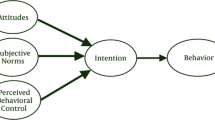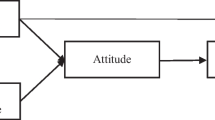Abstract
This study aims to add new variables, namely user interface, personal innovativeness, and satisfaction in learning, to Davis’s technology acceptance model and also examine whether learners are willing to adopt mobile learning. Thus, this study attempted to explain the structural causal relationships among user interface, personal innovativeness, perceived ease of use, usefulness, intention to use, and satisfaction in learning. A total of 350 students who enrolled in major courses of W Cyber University that provided mobile services responded to the survey. The results of the Structural Equation Modeling revealed that (1) user interface and perceived ease of use had significant effects on perceived usefulness; (2) user interface and personal innovativeness have significant effects on perceived ease of use; (3) perceived usefulness and perceived ease of use significantly affect satisfaction in learning; (4) perceived usefulness does not have significant effects on intention to use. The study has shown that usefulness and ease of use perceived by learners increase satisfaction in learning, and usefulness and satisfaction in learning create a positive intention to use. The findings of the study have highlighted user interface as an important factor that affects usefulness and ease of use perceived by learners.



Similar content being viewed by others
Explore related subjects
Discover the latest articles, news and stories from top researchers in related subjects.References
Agarwal, R., & Prasad, J. (1998). A conceptual and operational definition of personal innovativeness in the domain of information technology. Information Systems Research, 9(2), 204–215.
Baldonado, M. Q. (2000). A user-centered interface for information exploration in a heterogeneous digital library. Journal of the American Society for Information Science, 51(3), 297–310.
Bhattacherjee, A. (2001). Understanding information systems continuance: An expectation–confirmation model. MIS Quarterly, 25(3), 351–370.
Bhuatti, T. (2007). Exploring factors influencing the adoption of mobile commerce. Journal of Internet Banking and Commerce, 12(3), 13.
Carlisir, F., & Carlisir, F. (2004). The relation of interface usability characteristics, perceived usefulness, and perceived ease of use to end-user satisfaction with enterprise resource planning (ERP) systems. Computers in Human Behavior, 20(4), 505–515.
Cheon, J., & Grant, M. M. (2012). The effects of metaphorical interface on germane cognitive load in web-based instruction. Educational Technology Research and Development, 60(3), 399–420.
Chiu, C. M., Hsu, M. H., Sun, S. Y., Lin, T. C., & Sun, P. C. (2005). Usability, quality, value and e-learning continuance decisions. Computers & Education, 45, 399–416.
Cho, V., Cheng, T. C. E., & Lai, W. M. L. (2009). The role of perceived user-interface design in continued usage intention of self-paced e-learning tools. Computer & Education, 53, 216–227.
Chung, N., & Kwon, S. J. (2009). The effects of customers mobile experience and technical support on the intention to use mobile banking. Cyber Psychology & Behavior, 12(5), 539–543.
Davis, F. D. (1989). Perceived usefulness, perceived ease of use, and user acceptance of information technology. MIS Quarterly, 13(3), 319–340.
Davis, F. D., Bagozzi, R. P., & Warshaw, P. R. (1989). User acceptance of computer technology: A comparison of two theoretical models. Management Science, 35(8), 982–1003.
Davis, F. D., & Venkatesh, V. (1996). A critical assessment of potential measurement biases in the technology acceptance model: Three experiments. International Journal of Human-Computer Studies, 45(1), 19–45.
DeLone, W. H., & McLean, E. R. (1992). Information systems success: The quest for the dependent variable. Information Systems Research, 3(1), 60–95.
Devaraj, S., Fan, M., & Kohli, R. (2002). Antecedents of B2C channel satisfaction and preference: Validating e-commerce metrics. Information Systems Research, 13(3), 316–333.
Erdogan, M., Usak, M., & Aydin, H. (2008). Investigating prospective teachers’ satisfaction with social services and facilities in Turkish universities. Journal of Baltic Science Education, 7(1), 17–26.
Fagan, M., Kilmon, C., & Pandey, V. (2012). Exploring the adoption of a virtual reality simulation: The role of perceived ease of use, perceived usefulness and personal innovativeness. Campus-Wide Information Systems, 29(2), 117–127.
Fishbein, M., & Ajzen, I. (1975). Belief, attitude, intention, and behavior: An introduction to theory and research. Reading, MA: Addison-Wesley.
Gatsou, C., Politis, A., & Zevgolis, D. (2011). Text vs visual metaphor in mobile interfaces for novice user interaction. Information Services & Use, 31, 271–279.
Hiltunen, M., Laukka, M., & Luomala, J. (2007). Mobile user experience. (D. Y. Na, Trans.). Seoul: Hanvit media.
Hong, J. C., Hwang, M. Y., Husa, H. F., Wonga, W. T., & Chena, M. Y. (2011). Applying the technology acceptance model in a study of the factors affecting usage of the Taiwan digital archives system. Computers & Education, 57(3), 2086–2094.
Huang, J. H., Lin, Y. R., & Chuang, S. T. (2007). Elucidating user behavior of mobile learning: A perspective of the extended technology acceptance model. The Electronic Library, 25(5), 586–599.
Hubona, G. S., & Blanton, J. E. (1996). Evaluating system design features. International Journal of Human-Computer Studies, 44, 93–118.
Hui, W., Hu, P. J. H., Clark, T. H. K., Tam, K. Y., & Milton, J. (2008). Technology-assisted learning: A longitudinal field study of knowledge category, learning effectiveness and satisfaction in language learning. Journal of Computer Assisted learning, 24, 245–259.
Joo, Y. J., Lim, K. Y., & Kim, E. K. (2011). Online university student’s satisfaction and persistence: Examining perceived level of presence, usefulness and ease of use as predictors in a structural model. Computer & Education, 57(2), 1654–1664.
Kim, J. H., & Ha, G. S. (2012). A study on the effects of corporate mobile social network service characteristics on user satisfaction and intention of continued usage. Digital Policy Research, 10(8), 135–148.
Kim, H., & Park, J. (2010). A study on the designing user interfaces for mobile web. Journal of Digital Design, 10(2), 65–74.
Kline, R. B. (2005). Principles and practice of structural equation modeling. NY: Guilford.
Koo, C. M., Kim, Y. J., & Nam, K. C. (2006). Antecedents of mobile commerce satisfaction and outcomes: Empirical test. Information Systems Review, 8(3), 105–123.
Lee, M. C. (2010). Explaining and predicting user’s continuance intention toward e-learning: An extension of the expectation–confirmation model. Computer & Education, 54(2), 506–516.
Lee, T. J. L., & Roh, Y. H. (2004). Ecotourist’s satisfaction and behavioral intention. Journal of Tourism and Leisure Research, 16(4), 111–130.
Legris, P., Ingham, J., & Collerette, P. (2003). Why do people use information technology? A critical review of the technology acceptance model. Information & Management, 40(3), 191–204.
Lewis, W., Agarwal, R., & Sambamurthy, V. (2003). Sources of influence in beliefs about information technology acceptance model. Information & Management, 40, 191–204.
Li, Y. Q., Qi, J. Y., & Shu, H. Y. (2008). Review of relationships among variables in TAM. Tsinghua Science & Technology, 13(3), 273–278.
Lin, T. C., & Chen, C. J. (2012). Validating the satisfaction and continuance intention of e-learning systems: Combining TAM and IS success models. International Journal of Distance Education Technologies, 10(1), 44–54.
Liu, I. F., Chen, M. C., Sun, Y. S., Wible, D., & Kuo, C. H. (2010a). Extending the TAM model to explore the factors that affect intention to use an online learning community. Computers & Education, 54, 600–610.
Liu, Y., Li, H., & Carlsson, C. (2010b). Factors driving the adoption of m-learning: An empirical study. Computer & Education, 55, 1214–1215.
Lu, J., Yu, C. S., Liu, C., & Yao, J. (2003). Technology acceptance model for wireless Internet. Journal of Internet Research, 13(2), 206–222.
McFarland, R. D. (1995). Ten design points for the human interface to instructional multimedia. T.H.E. Journal, 22(7), 67–69.
Phillips, D. (2012). How to develop a user interface that your real users will love. Computer in Libraries, 32(7), 6–15.
Rai, A., Lang, S. S., & Welker, R. B. (2002). Assessing the validity of IS success models: An empirical test and theoretical analysis. Information Systems Research, 13(1), 50–69.
Roca, J. C., Chiu, C. M., & Martinez, F. J. (2008). Understanding e-learning continuance intention: An extension of the technology acceptance model. Human-Computer Studies, 64, 683–696.
Rogers, E. M. (1995). Diffusion of innovation. New York: Free Press.
Sass, D. A., & Smith, P. L. (2006). The effects of parceling unidimensional scales on structural parameter estimates in structural equation modeling. Structural Equation Modeling, 13(4), 566–586.
Shin, N. (2003). Transactional presence as a critical predictor of success in distance learning. Distance Education, 24(1), 69–86.
Shin, D. H., Shin, Y. J., Choo, H., & Beom, K. (2011). Smartphone as smart pedagogical tools: Implications for smartphones as ubiquitous learning devices. Computers in Human Behavior, 27(6), 2207–2214.
Smet, D. C., Bourgonjon, J., Wever, B. D., Schellens, T., & Valcke, M. (2012). Researching instructional use and the technology acceptance of learning management systems by secondary school teachers. Computer & Education, 58, 688–696.
Sun, P. C., Tsai, R. J., Finger, G., Chen, Y. Y., & Yeh, D. (2008). What drives a successful e-Learning? An empirical investigation of the critical factors influencing learner satisfaction. Computers & Education, 50, 1183–1202.
Taylor, S., & Todd, P. A. (1995). Understanding information on technology usage: A test of competing models. Information Systems Research, 6(2), 144–176.
Thong, J. Y. L., Hong, W., & Tam, K. Y. (2002). Understanding user acceptance of digital libraries: What are the roles of interface characteristics, organizational context, and individual differences? Human-Computer Studies, 57, 215–242.
Thong, J. Y. L., Hong, S., & Tam, K. Y. (2006). The effects of post-adoption beliefs on the expectation–confirmation model for information technology continuance. International Journal of Human-Computer Studies, 64(9), 799–810.
Van Raaji, E., & Schepers, J. (2008). The acceptance and use of a virtual learning environment in China. Computers & Education, 50, 838–852.
Venkatesh, V., & Davis, F. D. (2000). A theoretical extension of the technology acceptance model: Four longitudinal field studies. Management Science, 46(2), 186–204.
Yang, Y. S., & Shin, C. H. (2010). A study on the effects of mobile phone user interface characteristics on customer service usage; with emphasis on the technology acceptance theory. Commodity Science & Technology Research, 28(2), 1–16.
Acknowledgments
This work was supported by National Research Foundation of Korea Grant funded by the Korean Government (2012-045331).
Author information
Authors and Affiliations
Corresponding author
Rights and permissions
About this article
Cite this article
Joo, Y.J., Lee, H.W. & Ham, Y. Integrating user interface and personal innovativeness into the TAM for mobile learning in Cyber University. J Comput High Educ 26, 143–158 (2014). https://doi.org/10.1007/s12528-014-9081-2
Published:
Issue Date:
DOI: https://doi.org/10.1007/s12528-014-9081-2




